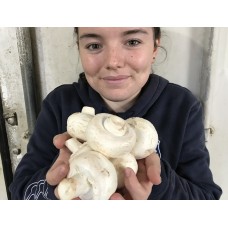Availability: In Stock
Mushrooms add flavour to many dishes... very versatile & popular...
Can be used with meat, in soups, sauces, on pizzas, in casseroles, in stir-fries, in omelettes, in pies & salads...they can be used whole, sliced or quartered.
Refridgerate in a paper bag.
Mushrooms are the 4th most popular vegetable in New Zealand.
Small white mushrooms with a mild flavour
Mushrooms are a healthy source of Selenuim, Phosphorous & Potassium - essential minerals for brain development in young children.
4-5 Button mushrooms provide 0 grams of fat & 18 calories.
Mushrooms help improve Immune function, lowering risk of cancer & heart disease
Got brain fade? The biotin, niacin, pantothenic acid, riboflavin, copper & potassium found in mushrooms are important in keeping your nervous system functioning properly & assisting with neurological function, mental performance & psychological development.
Big words, but basically it helps your brain & nervous system function normally.
Selenium helps maintain normal hair & nails, & is necessary for normal immune function in the human body.
Mushrooms are a rich source of ergothioneine, an antioxidant that may help fight cancer
Mushrooms are alsoa source of riboflavin, a vitamin that supports the body's natural detoxification mechanisms
They are the highest vegan source of Vitamin D
With many of the nutritional attributes of vegetables, mushrooms also provide those nutrients more commonly found in meat, beans & grains
Mushrooms are low in calories & carbohydrates, fat-free, cholesterol-free, gluten-free, & very low in sodium,yet they provide important nutrients, including selenium, potassium, riboflavin, niacin, vitamin D & more.
It’s obvious why they are classed as one of the top superfoods.
This reduces air flow & moisture so they’ll last longer.
Pop them in the salad drawer in your fridge.
It may have several settings, check for the one with the mushroom symbol.
Try not to put anything on top of them, mushrooms bruise easily.
You can also freeze mushrooms.
Arrange them in a single layer on a tray & pop them in the freezer.
There’s no need to peel your mushrooms.
Just like other vegetables, a lot of the goodness lies in the outer layer.
Don’t discard the stalks – these are just as nutritious as the mushroom caps.
You can always freeze the stalks for use in soups if you don’t want them in your dish.
Depending on your dish, you can then serve them whole, quarter, slice or dice them.
Julia & Libby eating for health - Mushrooms
Mushroom Recipes
| Nutrition Information | ||||
| Serving size: 1 cup sliced 108 g | ||||
|
Average Quantity per serving |
% Daily intake per serve |
Average Quantity per 100g |
||
| Energy (kJ/Cal) | 78/19 | 1% | 72/17 | |
| Protein (g) | 2.3 | 5% | 2.2 | |
| Fat, total (g) | 0.3 | 0% | 0.3 | |
| - saturated (g) | 0.03 | 0% | 0.03 | |
| Carbohydrate (g) | 0.8 | 0% | 0.7 | |
| - sugars (g) | 0.6 | 1% | 0.6 | |
| Dietary fibre (g) | 1.7 | 6% | 1.6 | |
| Sodium (mg) | 4 | 0% | 4 | |
| Niacin (mg) | 5.4 | 54% RDI* | 5.0 | A source of niacin |
| Vitamin B6 (mg) | 0.24 | 15% RDI* | 0.22 | A source of vitamin B6 |
| Potassium (mg) | 400 | 370 | Contains potassium | |
| Selenium (µg) | 21.3 | 30% RDI* | 19.7 | |
| Riboflavin (mg) | 0.59 | 35% RDI* | 0.6 | |
|
Percentage Daily Intakes are based on an average adult diet of 8700 kJ |
||||
|
Source: The Concise New Zealand Food Composition Tables, 12th Edition, Plant & Food Research - 2018 |
||||







-74x74.jpg)


